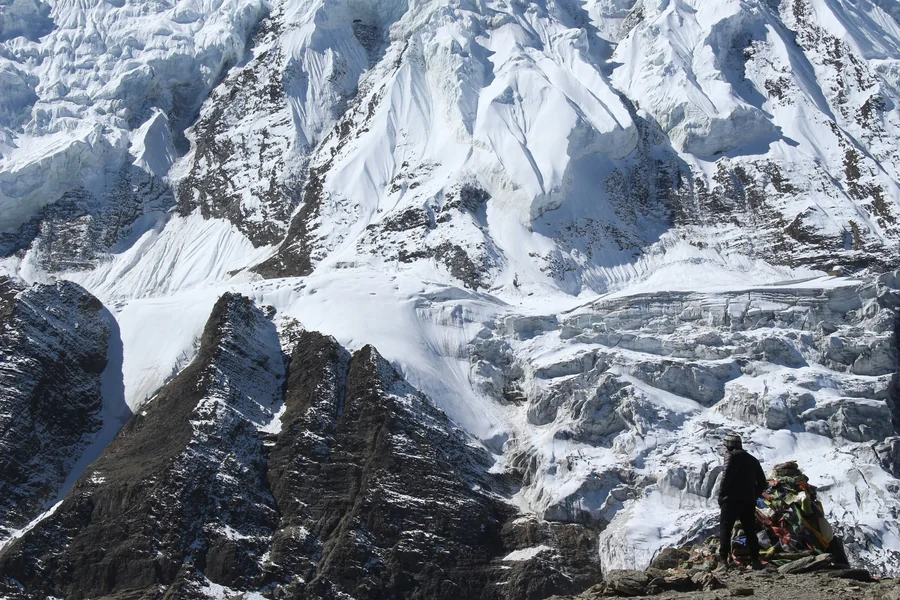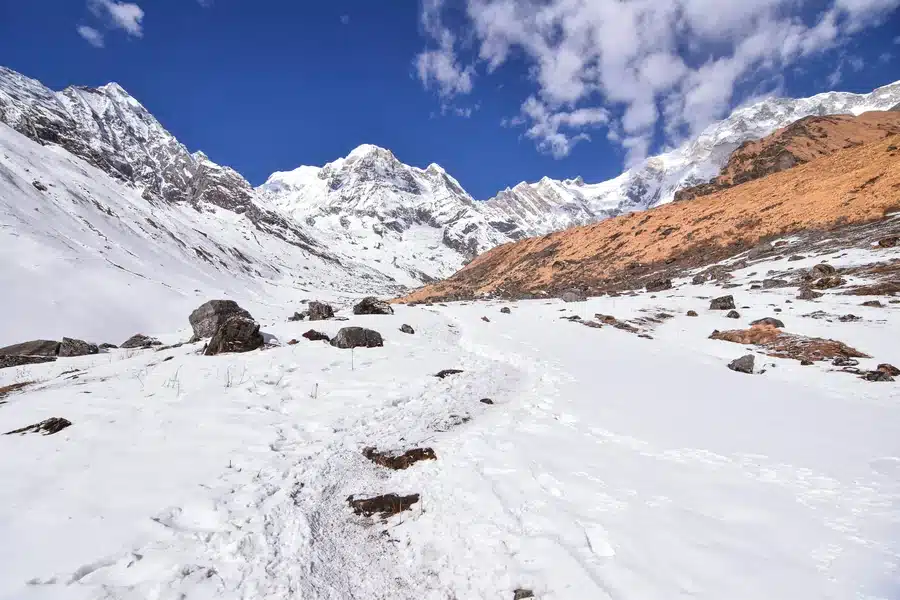Somewhere in the heart of the Himalayas, where prayer flags flutter like whispered secrets and the trail vanishes into mist, lies an experience that defines trekking in Nepal: staying in a teahouse. It’s not a hotel, not quite a homestay, and certainly not a hostel. It’s something else entirely. Something quieter. Simpler. More human.
In a world wired for speed, the teahouse is a place where time softens. Here, you warm your hands around a mug of ginger tea as your boots steam by the fire.
You listen to the silence of the mountains and the laughter of strangers becoming friends. And each night, under a sky littered with stars, you realize that this, not the summit, not the pass, might be the part of the journey you’ll carry home the longest.
Let’s step through the doorway of the Himalayan teahouse and discover what it’s really like to stay in one along the Annapurna Circuit Trek.
The First Door You Open: Arriving at a Teahouse After the Trail
The trail unspools behind you like a story half-told. Your legs are heavy, your breath slow, your boots caked with mountain dust. Prayer flags flutter above you in tired celebration. Then, out of the mist or maybe just beyond the final bend, a structure appears, humble, timber-framed, and glowing faintly from within.
You step through the doorway, and suddenly the cold is behind you. There’s a soft crackle of firewood, the quiet scrape of ladles against pots, the comforting murmur of voices layered like blankets. The smell of spiced tea wraps around your shoulders as your pack hits the floor.
No check-in counters. No digital keys. Just warmth, simplicity, and a place to be still. You’ve arrived at a Himalayan teahouse, and you’re exactly where you need to be.
More Than Shelter: The Heartbeat of Himalayan Hospitality
A Himalayan teahouse doesn’t offer five stars, but it offers five smiles before you’ve even taken off your boots. It’s not just a roof over your head; it’s a refuge built from generations of care, weathered timber, and an unspoken vow to welcome the weary.
The host doesn’t ask for your ID, they ask if you’ve eaten. They don’t show you a room, they show you kindness. In these quiet corners of the mountains, hospitality isn’t a service. It’s a way of life. And as a steaming cup of ginger tea lands in your hands, you’ll feel the warmth not just on your palms, but in your heart.
This is more than shelter. This is being seen. This is being home, even when you’re half a world away.
Bedrooms Without Luxury — But Not Without Charm

These rooms don’t whisper luxury, they hum humility. The walls are carved from weathered wood, thin enough to hear your neighbor breathing, and the single light bulb glows like a mountain star resisting the dark. No thermostats, no polished tiles, no thick curtains, just honest architecture shaped by altitude and necessity.
The bed creaks like it remembers every dream that passed through it. The mattress is firm, the blanket heavy with warmth, and the pillow shaped by memory. Outside, the wind doesn’t howl, it sings. You nestle into your sleeping bag, cocooned not by comfort but by stillness.
Here, peace is not promised; it is earned. In the quiet, in the cool, in the knowledge that the mountain is just outside your frosted window, standing silent watch through the night, you find a deeper kind of rest. Not the luxury of opulence, but the rare privilege of presence.
Dining Rooms of Shared Stories and Steam
The dining room of a Himalayan teahouse is less a space and more a ceremony. As the cold blue of twilight settles outside, amber light flickers from butter lamps and fire stoves, casting soft shadows on weathered walls. Steam rises in elegant spirals from mugs of masala tea, scenting the air with cardamom and comfort.
Here, strangers become something more. A nod turns into a story. A shared table becomes a shared memory. There are no name tags or small talk, just the common language of tired legs, satisfied bellies, and the sacred act of rest. Laughter skips across the wooden tables, and so does silence, the kind that says everything without a single word.
Dal bhat arrives, endlessly refillable and soul-warming, passed around like an offering. Someone pulls out a deck of cards, someone else a guitar. And beneath it all, the fire hums like a heartbeat.
This is where the trail is retold, in stories, in steam, in the warmth of people who’ve walked different paths to arrive at the same glowing room. This is the soul of the teahouse.
If you’re drawn to this kind of quiet rhythm, where every sunrise feels like a blessing and every teacup feels earned, consider also exploring the Langtang Trek. Tucked away in the northern reaches of Nepal, it offers a similarly intimate experience of teahouse trekking, but with its own unique blend of remoteness, serenity, and soulful scenery.
The Small Joys and Quirks of Daily Life
You learn the rhythm not from a guidebook, but from the breath of the mountain. Mornings begin with the blush of sunrise painting the peaks, followed by a gentle scramble for the solar-heated shower that may or may not be warm. There’s one charging socket shared by everyone, a modern campfire where phones, power banks, and stories all wait their turn.
Wi-Fi signs hang on the walls like half-promises, but the signal is never stronger than the silence outside. So, you unplug. You start to look up. You laugh more, check your phone less. You start to feel human again.
Life distills to its simplest parts: walking, eating, listening, resting. And in that simplicity, you find something rare: a quiet joy in the ordinary, a deep contentment that no app or itinerary can replicate.
Meals Cooked with Altitude and Heart
The menu in a Himalayan teahouse reads like a mantra, the same few offerings in every village: dal bhat, momos, garlic soup, fried noodles, pancakes. But within that repetition lies an extraordinary truth: no two meals ever taste the same.
Each dish is a quiet act of devotion, crafted by hands weathered by altitude and tradition. The cook is often your host, measuring garlic with instinct, and salt with memory. The dal bhat isn’t just food; it’s resilience in a bowl. It’s hot, nourishing, endlessly refillable, and somehow always just what your body and spirit need after a long day on the trail.
Dinner arrives not just with steam, but with soul. You eat beneath a flickering candle; the flame casting shadows on wooden walls while snow silently gathers on the windowsill. Outside: silence and stars. Inside: warmth, spice, and a full belly.
In these heights, cuisine doesn’t chase complexity, it clings to comfort. And somewhere between the second helping of rice and the third cup of tea, you realize that this is not just a meal, it’s a memory made edible.
A Culture of Care: The Unseen Effort Behind Your Stay
Long after you’ve peeled off your boots and sunk into warmth, the quiet work continues. Behind the kitchen door, someone is chopping vegetables with a headlamp. Outside, someone else is gathering firewood before the frost sets in. A teahouse hums not with luxury, but with devotion.
It isn’t a business in the corporate sense; it’s a home opened to strangers. Every blanket you’re handed has been sun-dried and folded with care. The warmth from the stove isn’t just firewood, it’s someone’s 5am labor. Even the floorboards that creak beneath your socks have been swept with pride.
The host’s kindness is rarely loud, it lives in the way they remember your tea order, or how they slip an extra blanket onto your bed when the wind howls. And when morning comes and you shoulder your pack once more, they don’t just wish you well, they send you off with something sacred: quiet care you’ll carry long after the trek is done.
While teahouses nurture the soul, it’s important to also protect the body, especially in high-altitude, remote environments like the Annapurna Circuit. From altitude sickness to food hygiene, preparation is key. Before your trek, it’s worth reviewing essential travel medicine and vaccine tips to ensure your adventure is not only memorable but also safe and healthy. A little precaution goes a long way when you’re this far from home.
The Rhythm of the Trail, Written in Wood and Smoke

Trekking the Annapurna Circuit is not about racing from point A to B; it’s about surrendering to the pace of the path. With every step, life begins to echo the landscape: slow, steady, unhurried.
Days fall into a quiet cadence, not dictated by clocks but by clouds, footfalls, and the scent of simmering soup on the breeze. You rise with the golden hush of morning light, walk until the mountains pull you into stillness, and end each day in the warm cradle of a teahouse. Wash. Rest. Eat. Sleep. Repeat.
But within this repetition lives surprise. A trail bends unexpectedly to reveal a hanging glacier. A stranger’s story shared over tea that lingers longer than the sunset. A silent monastery with butter lamps flickering like old prayers.
Here, the journey isn’t something you push through, it’s something that seeps into you. Slowly. Gently. Completely.
When the Fire Burns Low: What You’ll Remember
You won’t remember the dimensions of the room or the color of the sheets. But you’ll remember the woman who filled your cup with ginger tea, her fingers cracked by frost but her smile steady and kind. You’ll remember the Swiss trekker who broke his last chocolate bar in half and passed it across the table without a word. You’ll remember how the fire dimmed to embers and the silence in the room grew rich, not empty.
You’ll remember how your breath curled in the moonlight when you stepped outside and looked up at stars stitched across the night sky. You’ll remember how the cold bit your skin, but the memory, that fleeting, fragile moment, warmed something far deeper.
Because in the end, it’s not what the room looked like, it’s what it held. Stories. Stillness. And a piece of your heart you didn’t know you had left to give.
A Cup of Tea and a Window to the Peaks
In the end, it isn’t the highest pass or the hardest climb that stays with you; it’s the stillness of a dining room warmed by firelight, the way tea tastes sweeter at altitude, the soft hush of boots left at the door. Teahouses are where the soul of the Annapurna Circuit quietly lives: in rice bowls refilled without asking, in laughter shared without knowing names, in quiet care stitched into the simplest of comforts.
Here, luxury isn’t something you buy, it’s something you feel. In the silence between conversations. In the steam that curls from your cup. In the open window that frames a view too vast for words.
You leave with your legs tired and your spirit full. You leave with stories, with reverence, with the gentle ache of having been somewhere honest. And maybe, just maybe, you leave a little closer to yourself.



